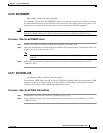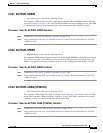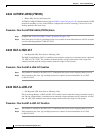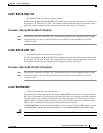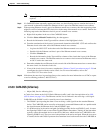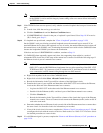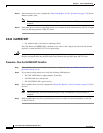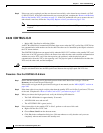
2-33
Cisco ONS 15327 Troubleshooting Guide, R3.4
March 2004
Chapter 2 Alarm Troubleshooting
Alarm Procedures
Note When replacing a card with an identical type of card, no additional CTC provisioning is
required.
Step 8 If a CARLOSS alarm repeatedly appears and clears, use the following steps to examine the layout of
your network to determine whether the Ethernet circuit is part of an Ethernet manual cross-connect.
Step 9 If the reporting Ethernet circuit is part of an Ethernet manual cross-connect, then the reappearing alarm
might be a result of mismatched STS circuit sizes in the setup of the manual cross-connect. Perform the
following steps unless the Ethernet circuit is part of a manual cross-connect:
a. Right-click anywhere in the row of the CARLOSS alarm.
b. Click the Select Affected Circuits dialog box that appears.
c. Record the information in the Type and Size columns of the highlighted circuit.
d. From the examination of the layout of your network, determine which ONS 15327 and card host the
Ethernet circuit at the other end of the Ethernet manual cross-connect:
• Log into the ONS 15327 at the other end of the Ethernet manual cross-connect.
• Double-click the Ethernet card that is part of the Ethernet manual cross-connect.
• Click the Circuits tab.
• Record the information in the Type and Size columns of the circuit that is part of the Ethernet
manual cross-connect. The Ethernet manual cross-connect circuit connects the Ethernet card to
an OC-N card at the same node.
e. Determine whether the two Ethernet circuits on each side of the Ethernet manual cross-connect have
the same circuit size from the circuit size.
f. If one of the circuit sizes is incorrect, complete the “Delete a Circuit” procedure on page 2-128 and
reconfigure the circuit with the correct circuit size. For more information, refer to the
Cisco ONS 15327 Procedure Guide.
Step 10 If the alarm does not clear, log onto http://www.cisco.com/tac for more information or call TAC to report
a service-affecting problem (1-800-553-2447).
2.6.33 CARLOSS (G Series)
• Major (MJ), Service Affecting (SA)
A Carrier Loss alarm on the LAN G-Series Ethernet (traffic) card is the data equivalent of an LOS
(OC-N) alarm (see page 2-84). The Ethernet card has lost its link and is not receiving a valid signal.
CARLOSS on the G1000-2 card is caused by one of two situations:
• The G1000-2 port reporting the alarm is not receiving a valid signal from the attached Ethernet
device. The CARLOSS can be caused by an improperly connected Ethernet cable or a problem with
the signal between the Ethernet device and the G1000-2 port.
• If a problem exists in the end-to-end path (including possibly the far-end G1000-2 card), it causes
the reporting G1000-2 card to turn off the Gigabit Ethernet transmitter. Turning off the transmitter
typically causes the attached device to turn off its link laser, which results in a CARLOSS on the
reporting G1000-2 card. The root cause is the problem in the end-to-end path. When the root cause
is cleared, the far-end G1000-2 port turns the transmitter laser back on and clears the CARLOSS on



